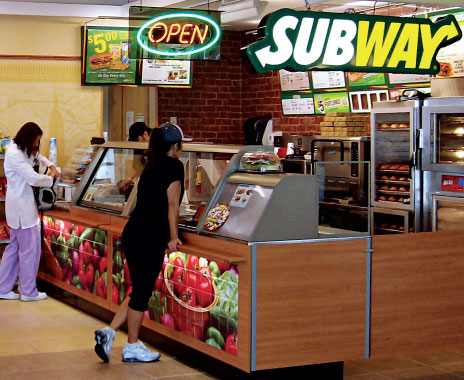It might seem like quick-serve concepts and hospitals are headed for an epic breakup, as some brands have come under fire for their presence in places meant to heal. The American Hospital Association labeled unhealthy foods “environmental inconsistencies,” whether they’re served out of vending machines, cafeterias, or franchised units in hospital food courts.
But hospital and restaurant experts say there is more opportunity than ever for quick-service brands—that is, for the right quick-service brands. Major changes in health-care financing mean hospitals and health-care systems are eager to open up new revenue streams by leasing restaurant space. Many hospitals can no longer afford to operate their cafeterias in the late-night or early-morning hours, while doctors, nurses, and technicians still need to eat at all hours and usually within a short 30 minutes.
Toni Watkins of Texas Health Presbyterian Hospital in Dallas says the potential for quick-serve concepts that can make a play at healthy eating in this nontraditional space is only growing.
“I think they’ll always have a place, as long as they are the right brand,” says Watkins, the director of food, nutrition, and conference services. “Because, as health care is changing and the cost of doing business is changing, the brands help to give relief to profits that are being lost.”
The Dallas hospital already had a Subway franchise when Watkins joined four years ago. Since then, Au Bon Pain has come on board, and the hospital is gearing up to open its own Chick-fil-A unit. Watkins says the hospital specifically chose those brands because of the healthy options they offer. Even though Chick-fil-A sells fried chicken and french fries, she says, the brand offers an array of lighter options.
Most hospitals are moving away from options like greasy burgers and fries, she adds. But quick serves, even traditional burger concepts, can compete in hospitals by tweaking their menus specifically for the space by paring down unhealthy options and highlighting the lighter side of the menu.
“I think that those [less-healthy] brands would need to go to hospitals and show what they can do with healthy initiatives. It could be that they might be willing to do a different type of branding,” Watkins says. “I think they have an opportunity to rebrand themselves for healthy eating and meet a different kind of need. And let’s face it, a lot of those quick-serve companies have those other menus.”
For hospitals, it’s a tricky balance of meeting demand, promoting healthy choices, and managing their own brand image. Susan Levin, director of nutrition education for the Physicians Committee for Responsible Medicine, says consumers associate a restaurant brand as being healthy just by its presence in a health-care environment.
Hospitals are getting more responsible about the food choices they offer, both in the cafeteria and in name-brand outlets, Levin says, and brands that are willing to promote their healthy choices by offering point-of-sale information about calories, fat, and sodium can be responsible foodservice partners for health facilities. “We know when there is [information], people make better choices,” she says. “So at least give them better information about how to make healthier choices.”
That’s a major reason for Subway’s inroads in the hospital arena. It has fresh vegetables and sandwiches that hold the American Heart Association stamp of approval, and it recently eliminated undesirable ingredients from its breads. The brand also clearly labels nutritional information—a feature more hospitals seek.
“When you look at the [quick-serve] landscape, we have the benefit of having that health halo, so to speak,” says chief development officer Don Fertman. “And certainly when hospitals are looking for [quick-serve] partners, we tend to be one of the go-tos.”
Subway operates in 276 hospitals, including in some of the biggest names in medicine, like Duke University Hospital and Texas Children’s Hospital.
“We have one hospital store that is so busy that there’s one employee who spends their entire time simply baking bread,” Fertman says. “It certainly shows that there is a market there. … And of course, it’s a captive audience.”
Demand for healthy choices is constantly rising, both in the consumer marketplace and in hospitals. Sodexo is one example of a big supplier for hospital cafeterias that also operates some franchised units in hospitals. Its Mindful line of healthy menu options offers meals and entrées with less than 600 calories and desserts with less than 200 calories.
“With health-care reform, hospitals are wanting to be pillars in their community for health and wellness,” says Sodexo’s Shelley Kalfas, senior vice president of marketing. “They’re all looking to build a culture of wellness that includes a food program.”
In addition to offering healthier alternatives in the cafeteria line and food court, hospitals are working to improve offerings in vending machines and even internal convenience stores. Kalfas says the American hospital is changing from a place where sick people go to get better to a place of complete health, and restaurant brands must find a way to fit into that new image if they want a place in the world of health care.
“I think brands are going to need to, at a minimum, be able to highlight healthier choices on their menus and to have those as a prevalent part of what they’re offering, or it’s just not going to meet the image of health and wellness that hospitals are wanting to present,” Kalfas says.









